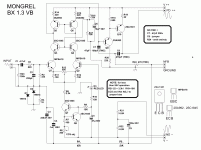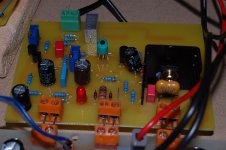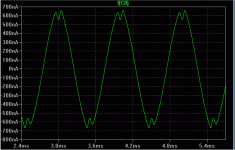No doubt the bjts you re talking about are rugged as well,
but we re talking of 2SJ48/49/50 and their complementaries
2SK133/134/135 which are rated 7A/100W.
yes, I know
and I misunderstood you, sorry
hmm, these devices are not so good at higher voltage, but good a higher bias ?
or they are good at higher voltage, but not higher output
but thats contradicting
or it needs a caution, 8ohm no less
confusing 😕
I dont know, but in my "imagination", best is either one pair, or many
Sure that no pair at all is the only non adequate situation....
I have driven 2ohm Infinity Kappa9 with one pair of MJL21193/94
and they guy had never heard his speakers sound that good
from memory, supply voltage is about 30Vdc
but it needs a very good heatsink
I believe it , 4 amp DC soa on 50v rails - huge Die, 8mm ! I just ordered 20 of the NEW (njw - to-3p) 21193/4's... (only $1.40 each) , same soa ... but Hfe of over 100 , best of both worlds.
OS
TO-3 devices are a better hermetic seal than plastic devices and that might be a reason for using them in military environments. However, modern plastic devices are VERY good (I've seen Trench mosfet specimens do 2000 THB and still come out meeting spec on key paramters). 25 years ago, it was a completely different story. Now, they are used as standard in Auto applications with no problem. Use without fear!
Krisfr - Yes, they are superior thermally, mechanically, hermetically, etc. They can take more abuse, can be biased hotter, etc. Higher bias almost always equals better sonics. Is that really not enough benefits to use them over the plastic counterparts? Especially considering that Newark has 4000+ guaranteed to be original parts for $10 a piece. This is an absolute no brainer.
What advantages do the plastic ones have over the metal types? Other than the fact that one has to drill a few additional holes less?
What advantages do the plastic ones have over the metal types? Other than the fact that one has to drill a few additional holes less?
$10 a piece.
That is the difference between a 20$ OPS and a 160$ OPS. I could build 8 complete 200w current stages for 200$... each and every one would bury a goldmund in value and performance , have reduced PS switching pulses (I DO use snubbers) , be adjustable (I DO use a bias trimmer) , Share current gracefully between devices (I DO use emitter resistors) and generally last a lot longer than the overpriced joke of an amp known as the goldmund. At least , the 6K$ Genesis stealth had these basic engineering features to justify the exorbitant pricing.
Just about anything sounds better when ported to laterals , if you get fatigue free listening with a BJT OPS , things will only get better and simpler (no Vbe) when you switch to laterals.
Also , looking at the lowly simulations , it shows the goldmund has over a hundred times the high order harmonics than either of the SOTA amps. CRUDE overrated "puffery" , all based on the opinion of one person. I will be the first to build .. guaranteed .. and audition on both BJT and hitachi laterals. All that has been said over a thousand posts is pure speculation.
OMG,
OS
Ostripper - Can you post your schematic of what you believe to be the ultimate amplifier? I'm curious to take a look.
Off topic... Does anyone know of a decent free program online that would allow me to create professional looking schematics? Something that would have a database of already drawn parts that I could click and drag around, connect, name, etc. And that I could export the final project as .pdf, .psd, etc. Thanks!
Off topic... Does anyone know of a decent free program online that would allow me to create professional looking schematics? Something that would have a database of already drawn parts that I could click and drag around, connect, name, etc. And that I could export the final project as .pdf, .psd, etc. Thanks!
I use Eagle from Cadsoft. CadSoft Online: EAGLE Layout Editor The freeware version is useful for schematic drawing, and can be useful for pcb desing, but only with limited size.
Sajti
Ostripper - Can you post your schematic of what you believe to be the ultimate amplifier? I'm curious to take a look.
I didn't say that lightly , I will be able to swap the one below out with any of the others within seconds. Don't be fooled by the utter simplicity , it really does do 10 parts per million at 50w/1k. Input device noise is more of a factor than any distortion product in this case.
OS
0 percent switching distortion , none of the goldmunds can pull that off. Last attachment is total cancellation of Xover dist. at miller loop ... giving class A like performance.
Attachments
Last edited:
1. They can take more abuse, can be biased hotter, etc. NO
2. Higher bias almost always equals better sonics. NO
3. Is that really not enough benefits to use them over the plastic counterparts WRONG BECAUSE 1 AND 2 ARE NOT VALID
Read my post again on the subject. There is NO reason now in 2010 to use TO3 over plastic.
And Ostripper is also correct. A $20 OPS wins hands down over a $200 OPS with the same performance.
2. Higher bias almost always equals better sonics. NO
3. Is that really not enough benefits to use them over the plastic counterparts WRONG BECAUSE 1 AND 2 ARE NOT VALID
Read my post again on the subject. There is NO reason now in 2010 to use TO3 over plastic.
And Ostripper is also correct. A $20 OPS wins hands down over a $200 OPS with the same performance.
1. They can take more abuse, can be biased hotter, etc. NO
2. Higher bias almost always equals better sonics. NO
3. Is that really not enough benefits to use them over the plastic counterparts WRONG BECAUSE 1 AND 2 ARE NOT VALID
Read my post again on the subject. There is NO reason now in 2010 to use TO3 over plastic.
And Ostripper is also correct. A $20 OPS wins hands down over a $200 OPS with the same performance.
Not to go the BJT way ,with original renesis 2sk1058/sj162's , your OPS would set you back $50usd , maybe 55$usd for the whole complete amp ... board and all.(no PS) besides having stellar performance , I'm sure the TMC would plow under the X-over distortion of the laterals just as good as the with the BJT's.
OS
Hey OS:
Where can I BUY those 2SK1058's and 2sj162's that are known to be GOOD parts today, I have got a board that is going to be stuffed shortly. Maybe about the time those parts could get here if I ordered them today.
Thanks
Where can I BUY those 2SK1058's and 2sj162's that are known to be GOOD parts today, I have got a board that is going to be stuffed shortly. Maybe about the time those parts could get here if I ordered them today.
Thanks
Last edited:
Oh, by the way, I am ONLY looking for PLASTIC parts...at least 8 pairs😉
A source of the LSK389as too would be helpful.
😀😛Source Emitter Resistor-Less TO-3's last longer than Plastic ones in that configuration. See I said something NICE about TO-3's.😛😀
A source of the LSK389as too would be helpful.
😀😛Source Emitter Resistor-Less TO-3's last longer than Plastic ones in that configuration. See I said something NICE about TO-3's.😛😀
Hey OS:
Where can I BUY those 2SK1058's and 2sj162's that are known to be GOOD parts today, I have got a board that is going to be stuffed shortly. Maybe about the time those parts could get here if I ordered them today.
Thanks
Tech DIY Company Store from our fellow member.
Can anyone here tell me how this TMC feedback network works....I can see that the current through the capacitors has a glitch...at the time where the output devices turns off...but how is it balanced and how are the values chosen..??
I didn't say that lightly , I will be able to swap the one below out with any of the others within seconds. Don't be fooled by the utter simplicity , it really does do 10 parts per million at 50w/1k. Input device noise is more of a factor than any distortion product in this case.
OS
0 percent switching distortion , none of the goldmunds can pull that off. Last attachment is total cancellation of Xover dist. at miller loop ... giving class A like performance.
Ostripper,
What is the purpose of the two -46mv DC voltage sources in your Mongrel simulation files? Without them the DC offset is about -2V if TMC is applied.
/Martti
Hey OS:
Where can I BUY those 2SK1058's and 2sj162's that are known to be GOOD parts today, I have got a board that is going to be stuffed shortly. Maybe about the time those parts could get here if I ordered them today.
Thanks
2SK1058 N-Channel MOSFET 160V 7A
or:
Audio Power Mosfets - Buy OnLine @ AmpsLab
By bohrok2610 - Ostripper,
What is the purpose of the two -46mv DC voltage sources in your Mongrel simulation files? Without them the DC offset is about -2V if TMC is applied.
Those are to drop the noise floor in LT to -180db. without them the DC offset is just uVolts. I do the same for a fet LTP , except the bias is microvolts instead of millivolts.
By Miib-Can anyone here tell me how this TMC feedback network works....I can see that the current through the capacitors has a glitch...at the time where the output devices turns off...but how is it balanced and how are the values chosen..??
And for the last question , TMC works as a nested feedback loop , it will take the "glitch" from the Xover region , feed that back to the VAS (into the miller loop) , cancelling out that distortion component. On a real amp , this can be experienced by scoping the OPS with less than adequate bias current. The tmc will compensate for even a 0-10ma BJT OP bias , this can be HEARD!! At the proper 70-80mA current , you approach perfection. TMC will only work with an amp that has a high loop gain (70+ db). It won't work on the original goldmund but will work on the beta enhanced version (keens/mine), and any blameless based amp with a 2 device beta enhanced VAS. (90-100db LG)
The values are chosen by calculating the 2 caps in series (100p-270 to 470p - 1:2.7 to 1:4)where they react the same (unity gain point - 875khz) as a 47-68pF conventional miller cap. I chose the feedback resistor by .step 'ing the value for the lowest THD PPM-(.step param rtmc 200 800 50). TMC works much better than the conventional 2 pole compensation as it includes the OPS in the feedback loop. 😎
Warning , these tricks might make your amp sound "sterile" , whether this is a good or bad thing would depend on your source(s).
OS
Last edited:
Those are to drop the noise floor in LT to -180db. without them the DC offset is just uVolts. I do the same for a fet LTP , except the bias is microvolts instead of millivolts.
In your simulation file you are bypassing the input cap. Take the bypass out and you will have DC offset.
/Martti
- Home
- Amplifiers
- Solid State
- Goldmund Mods, Improvements, Stability


